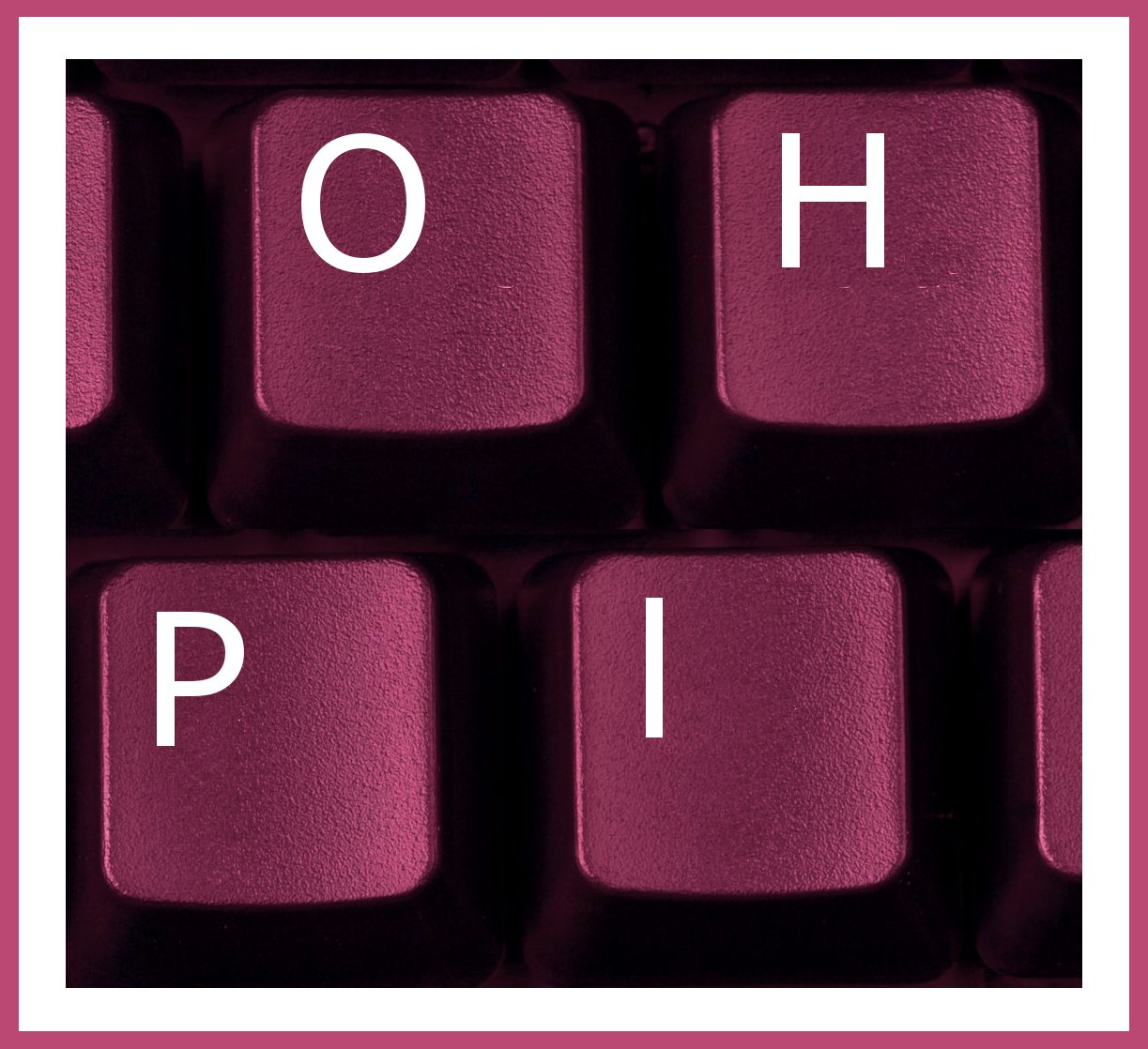Today, January 27th is International Holocaust Remembrance Day. It is a day we remember the victims of the Holocaust and Nazi persecution. It is a day designated by the United Nations General Assembly and commemorates the anniversary of the liberation of the Auschwitz-Birkenau concentration and extermination camp.
The Secretary General of the Council of Europe noted in 2020, that it is a day when we renew our commitment to do “our duty to ensure that such things can happen never again: that we do everything possible to prevent and to counter the hatred and prejudice that breeds violence and discrimination”.
There are those who seek to falsify history and deny or distort understanding of what occurred. The spread of Holocaust misinformation, particularly online, is a threat not only to memory, but to the commitment against the spread of hatred and prejudice. It is often inspired by a desire to glorify and repeat that dark past.
The Online Hate Prevention Institute (OHPI) is proud to be represented in Australia’s delegation to the International Holocaust Remembrance Alliance (IHRA) and to contribute to that inter-government organisation’s work in remembrance, education, and research. A key priority of IHRA in to #ProtectTheFacts about the Holocaust.
This year, on the 20th of January 2022, the UN General Assembly adopted a resolution which rejects and condemns without any reservation any denial and distortion of the Holocaust as a historical event. A spokesperson for the UN Secretary General issued a statement saying, “we can never let down our guard in the face of increasing attempts to deny, distort or minimize the Holocaust. We must also adapt and respond to new forms of antisemitism fueled by ignorance or conspiracy theories, also circulating online. Today’s resolution, adopted by consensus, makes it clear that all Member States must condemn and actively combat Holocaust denial.” In a recent briefing we discussed the UN resolution and the way it highlights the danger of misinformation and disinformation, particularly online, and how this can lead to hate and violence.
Online Hate Prevention Institute
The Online Hate Prevention Institute’s s CEO has been leading the fight against the spread of Holocaust denial and distortion on social media since 2008, including a 2011 call to Facebook to ban Holocaust denial (see Appendix B). The Online Hate Prevention Institute took on this work when we were established in 2012. Our very first report in 2012 started with an investigation into a video by a Holocaust denier which was banned repeatedly from YouTube. We have now been working on the problem of Holocaust denial and distortion online for over a decade.
After exposing the scale of Holocaust denial on YouTube in 2015, and work over the years on individual videos like “The Holocaust Fraud Exposed” (2015), we were pleased when YouTube notified us they were banning Holocaust denial in 2019. On Facebook we worked to remove pages like “The Untold History” (2013), “Proud to be a Holocaust denier” (2014), and many more. We were grateful when Facebook notified us of their change of policy to ban Holocaust denial in 2020. We hope other platforms will also adopt explicit policies to ban Holocaust denial, some like TikTok have already done so.
Holocaust denial, distortion, and misinfomation continues to spread online. Gab, for example, has a large number of explicit neo-Nazi individuals and groups that glorify Nazism. Despite changes in policy, Holocaust denial and distortion also continue to exists on mainstream social media platforms. Changes in policy do, however, make it easier to get the content removed. Today we are releasing a collection of 17 items of Holocaust denial content that, as of this week, was still Facebook. The content is documented below and we are working with Meta (Facebook) to secure its removal.
You can support this work tracking and removing Holocaust denial material like that below by making a donation to the Online Hate Prevention Institute’s campaign on Antisemitism and Holocaust denial below. Monthly donations and donations for other areas of our work can be made via our donations page.
The documented examples of Holocaust denial can be seen below.
The form is not published.
Holocaust Denial on Facebook Today
The affordances of the internet have contributed new ways of communication that can be used in positive ways, and, at the same time elements such as hashtags, sharing, the likes and dislike buttons ensure the magnification and wide dissemination of information and disinformation across social media platforms, including Holocaust denial. This can, and often does, bring together like-minded people – creating echo chambers and silos for disinformation to be reinforced.
Some of the content documented here is fairly recent, while other content has been on Facebook for many years. Old content, particularly in-depth posts and videos become assets that can be shared time and again. They can bring people deeper into these siloed networks and can serve as a means of spreading content across multiple platforms so its true impact isn’t immediately obvious. Recent content can be shared automatically with new people through the social media platforms’ algorithms or manual efforts to share it with a broader audience.
The content we examine includes two main forms of Holocaust denial posted on Facebook (or linked via Facebook): firstly, superficial content thrown about for shock value, and secondly, detailed information designed to indoctrinate and draw people into the world of the Holocaust deniers. Under Facebook’s Hate Speech policy, content “Denying or distorting information about the Holocaust” is a tier 1 breach and should be removed. This would cover both the superficial and the more in-depth content.
Update January 28th: Meta informed us this morning that they have removed all the items we shared with them. We have just completed verification and confirm they are now removed. We thank Meta for their swift action. The content below explains what was present at the start of Holocaust Memorial Day, and why it was removed.
The Videos
Example 1
A video posted with a comment that starts “An honest rabbi tells the truth about Holocaust” and ending with “#holohoax #holocausto is #HOAX. #Hitler #Jews”. The video itself features Rabbi Arye Friedman, a radical Rabbi who attended the Iranian Holocaust denial conference in 2006. The audio is captioned and claims he is saying that “global Zionism” is “fabricating lies about the Holocaust”. It features an article based on his interview with the headline “The Holocaust is a myth according to Rabbi Arye Friedmann”. The content, both the video and the accompanying post with its hashtags, provide clear case of Holocaust denial. The video was posted just over a month ago on December 21, 2021. It was still online as of Holocaust Memorial Day, January 27th 2022. Rabbi Friedman, who is an anti-Zionist activist, has refuted the claims made in the video. Holocaust deniers and other antisemites have a tendency to use Jews, and to misrepresent or recast what a Jew may say, in an attempt to lend legitimacy to Holocaust denial.

Example 2
A video posted with the comment starting “HAPPY HOLOHOAX REMEMBRANCE DAY ISRAEL!” and posted with links to 5 additional copies. The post was made in April 2017, just after Yom Hashoah, Israel’s national Holocaust Remembrance Day.
The creation and constant repetition of catchphrases such ‘Holohoax’ reinforce the disinformation behind Holocaust denial discourse. ‘Holohoax’ plays on the word holocaust, promotes the idea it was a hoax. It uses alliteration of the consonant ‘h’, further emphasised by adding the word happy in front, creating a rhythm that makes it easier to remember, repeat and internalise. The use of “Happy” in front of an event, festival or celebration (such as New Year, Holidays, Halloween) signals celebration, and in this instance is applied ironically and has the effect of satirising the reality of the Holocaust in a disrespectful manner.
The video includes a series of images which promote an “exposing the truth” discourse to undermine the reality of the Holocaust and persuade people it is a deception. One such image shows the word “Holocaust” setup like the Hollywood sign and a picture of a Rabbi holding a pile of money in front of it. This promotes a common form of Holocaust related disinformation that falsely claims the Holocaust is a myth created to scam money out of Germany.

The video proceeds with claims reflecting a common form of Holocaust distortion seen in the Former Soviet Union, which claimed “the Jews” were responsible for Communism and then holding Jewish people responsible for the death that occurred under the Soviet regime. One version has the added emphasis on “slaughter” and “Christians” which echoes the antisemitic blood libels.
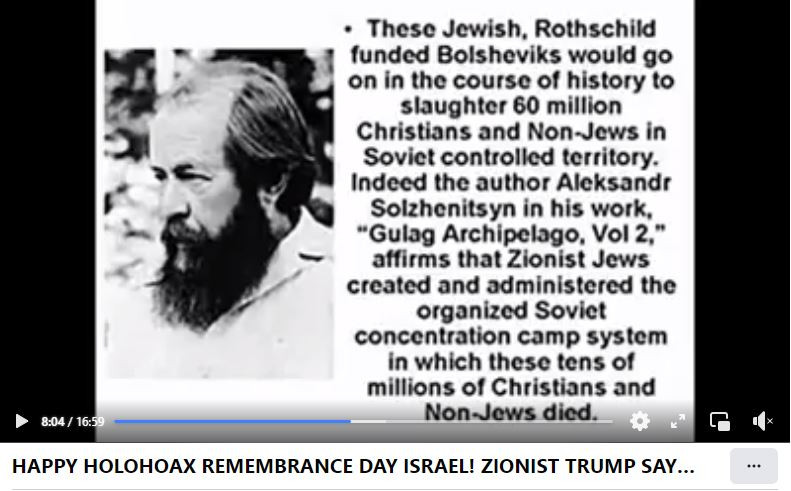
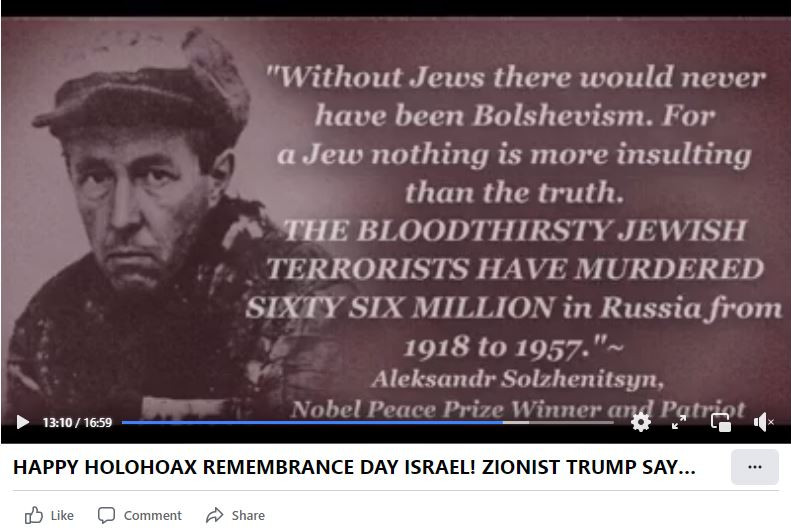
Post linking to a blog with disinformation
Example 3
This is a post on Facebook that shares a blog post, that in turn is a copy of a note on Facebook. Linking, sharing and commenting making the distribution of Holocaust denial much easier for the perpetrators of disinformation. This includes images (static and moving) as well as text.
In this example the material repeated across the three mediums, which adds no further authority and pushes the searcher to just give up on finding the original source, claims to be “A letter from Jewish French Dr. Roger Dommergue Polacco de Menasce to Stevens Spielberg”. The letter is part of the Holocaust denial disinformation cannon with copies found on blogs, social media, forums like the neo-Nazi site Stormfront, and pdf files claiming to be published by Historical Review Press, a known Holocaust denial website.
This hoax uses the technique of including a comment from a person claiming to be Jewish who then “comes clean” with the “truth” about the Holocaust. This seeks to strengthen the conspiracy discourse by lending false authority to it.

The linked blog:
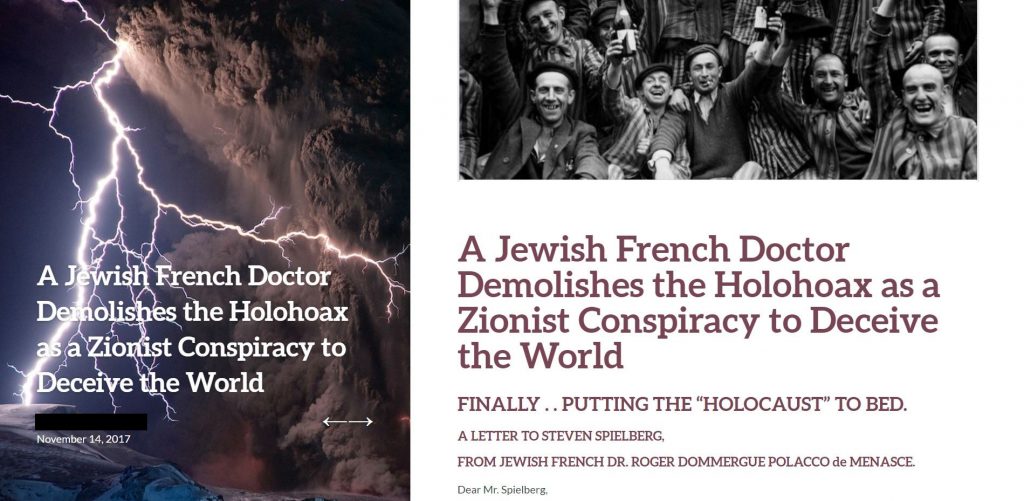
Bottom of the page featuring a link back to Facebook:
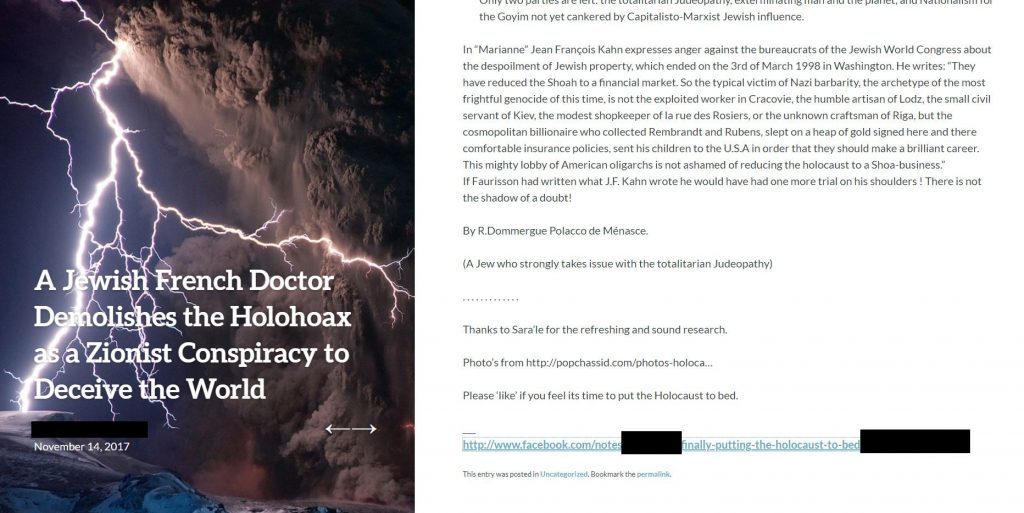
The linked Facebook note:
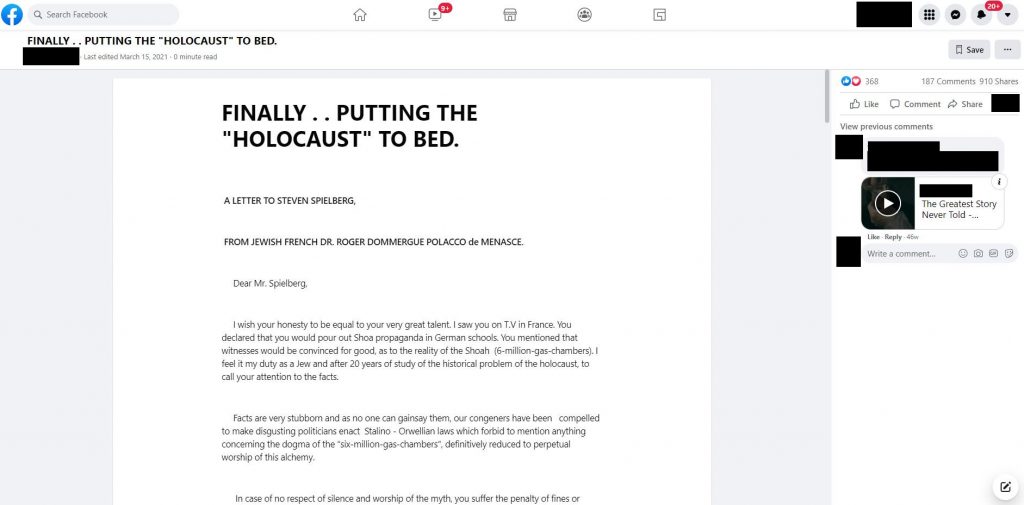
Publishing denial using Facebook notes
The last image above showed the use of a Facebook “note” to publish a longer article. Here are some additional examples of Holocaust denial making use of this functionality.
Example 4
This is a note that is also part of the cannon of Holocaust denial and distortion disinformation spread through social media, messages boards, and blogs.
This version of it is a misleading edit of an article written by Martin Hill a self-described Catholic paleoconservative and civil rights advocate. The original article and a rebuttal to it can be seen at the website Israel and Stuff. In it, Mr Hill writes about a Holocaust denial essay submitted by a 15 year old student and given an ‘A’, something he approves of. Hill’s article reproduces the student’s essay. This note is an edit which keeps Hill’s name and headline, but then removes all his commentary attributing the student’s essay to him as its author.

Example 5
This is a note in the form of an illustrated essay of Holocaust denial with classic denial images alleging photographs were faked, and complete with 9/11 antisemitic conspiracies. Here are some selections from what is a longer document:

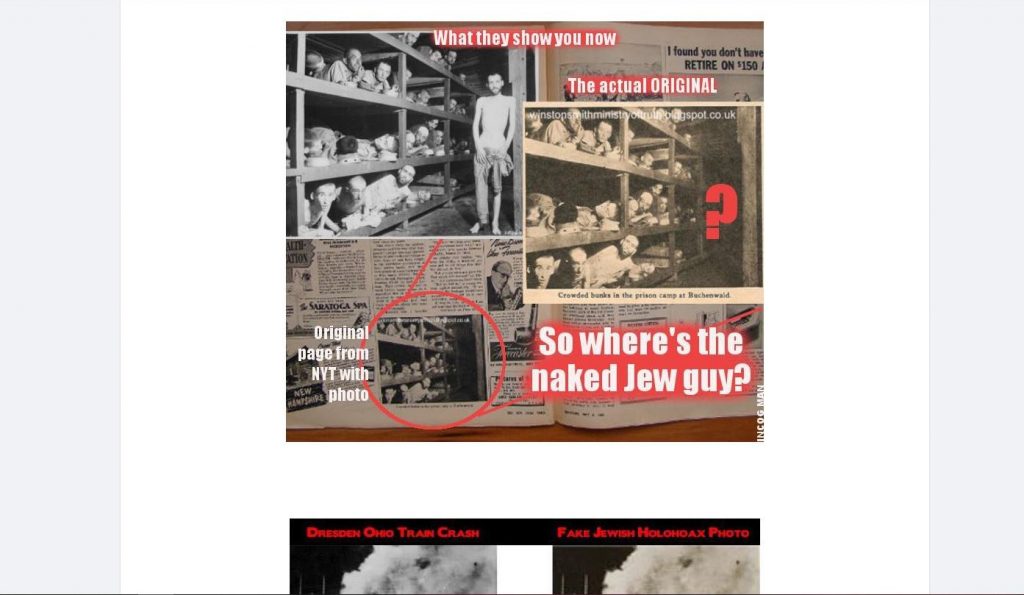
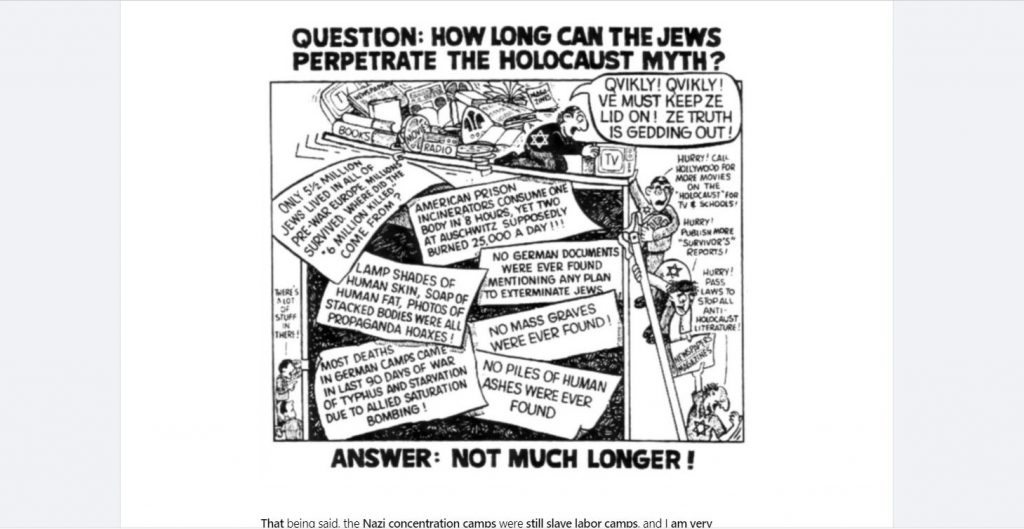
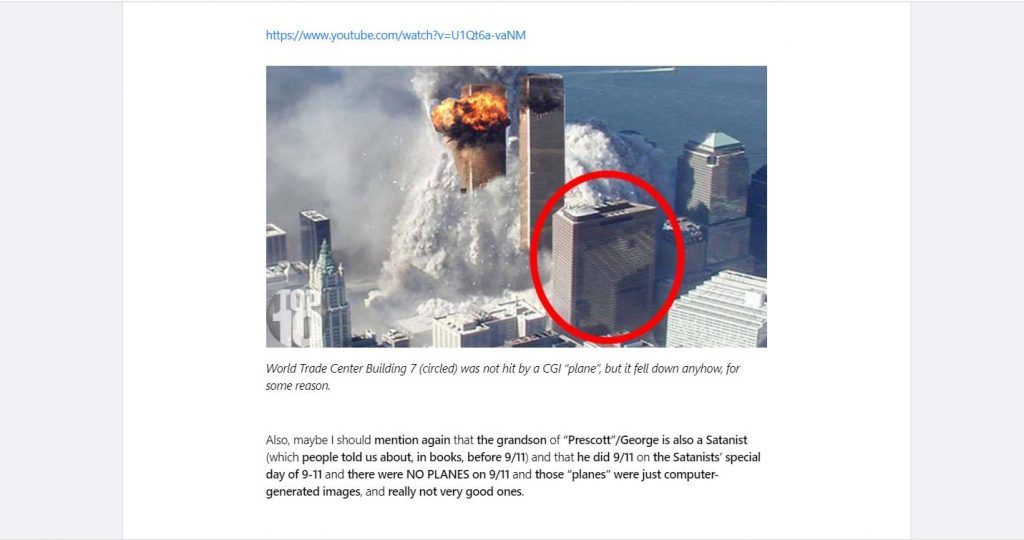
Comments
Comments on online content of the forms already discussed provided a source of additional Holocaust denial by other users. Holocaust denial content therefore inspires and facilitates further Holocaust denial content.
Example 6
The comments below are all in response to the note we have just discussed in example 5. The comments include promotion of Holocaust denier David Cole, claiming Jews were responsible for the Holocaust, and repeated classic denial arguments over the gas chambers.



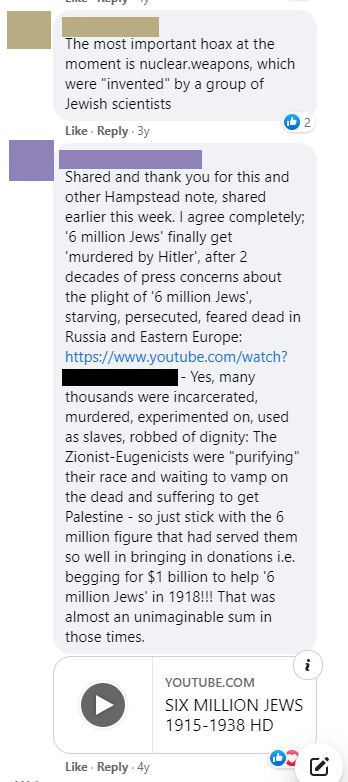
Using Facebook to spread Holocaust denial blogs
Example 7
This is a link to a post with a comment “Muh Holohoax” and speaking about “parasites using a Big Lie to destroy Civilization”. This is classic alt-right Holocaust denial and antisemitism. It draws on approaches of the Nazis themselves.

Example 8
This is a reference to a trial of a convicted Holocaust denier. The linked post is explicit Holocaust denial.

The is the linked blog post:

Example 9
This is a link to a blog post claiming the “greatest mass murderers were Jews agrees Jewish historian”. This content has been removed by the website hosting service for breach of its terms of service.
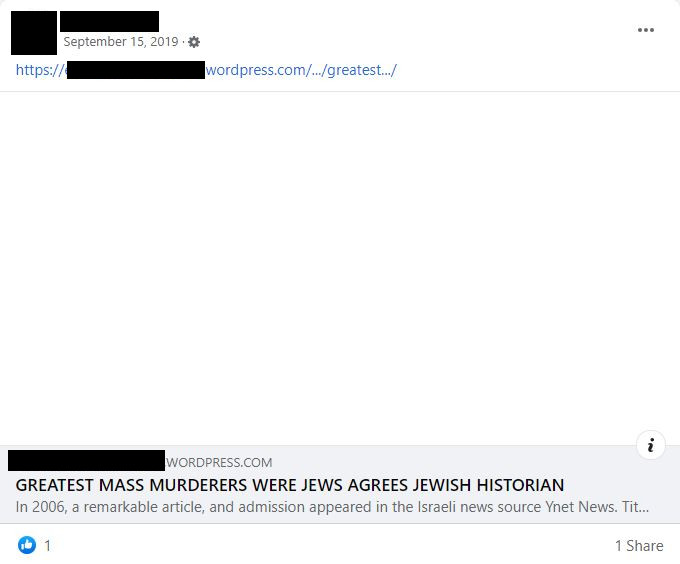

Automatic Pages
Examples 10 and 11
Facebook automatically generates pages for people’s interests. Two of these are #10 “the holohoax” and #11 “the holohoax revisionism”.


Images
Example 12
This is an image posted to Facebook with the hashtag #holohoax. It is a picture of a paper print out of antisemtiic material claiming the American government was controlled by global Jewish powers, that President Franklin Delano Roosevelt was merely their puppet, and that they pushed America into WWII.
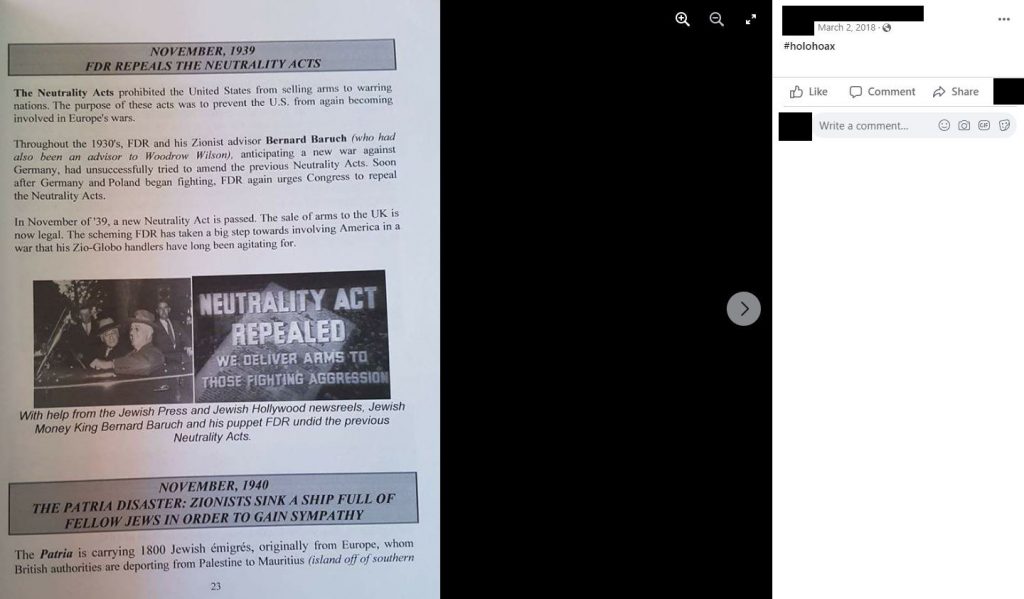
Example 13
This is an anti-Israel post that uses a series of antisemitic hashtags including #holohoax and #jewworldorder, another Jewish power conspiracy reference. In addition, it falsely accuses Israel of genocide.
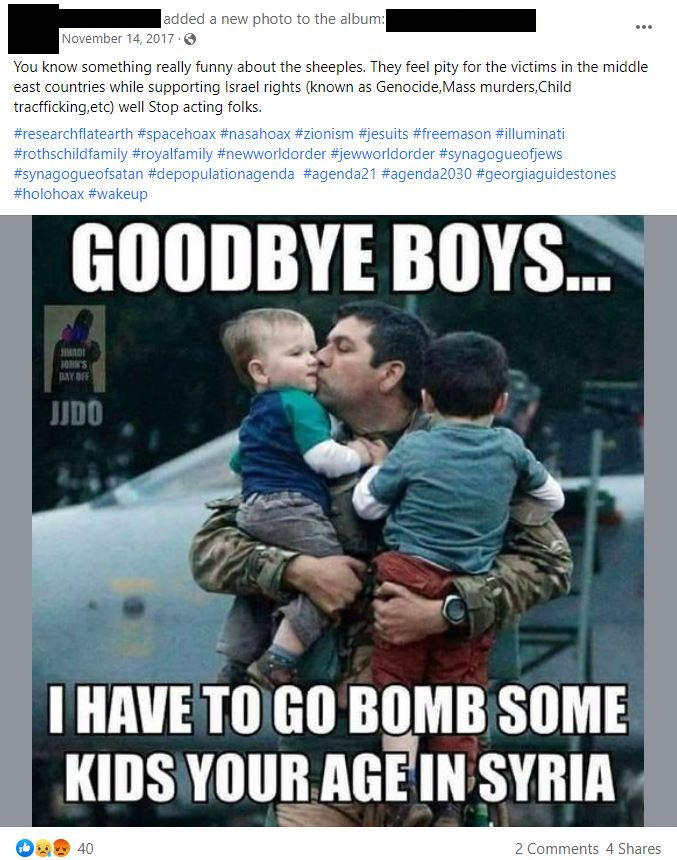
Example 14
This example repeats the hashtags from example 13.

Link Farm
A link farm is a guide to in-depth Holocaust denial and antisemitic material designed to take someone down the rabbit hole of indoctrination.
Example 15
This example is a mix of antisemitic anti-Zionist content and Holocaust denial.
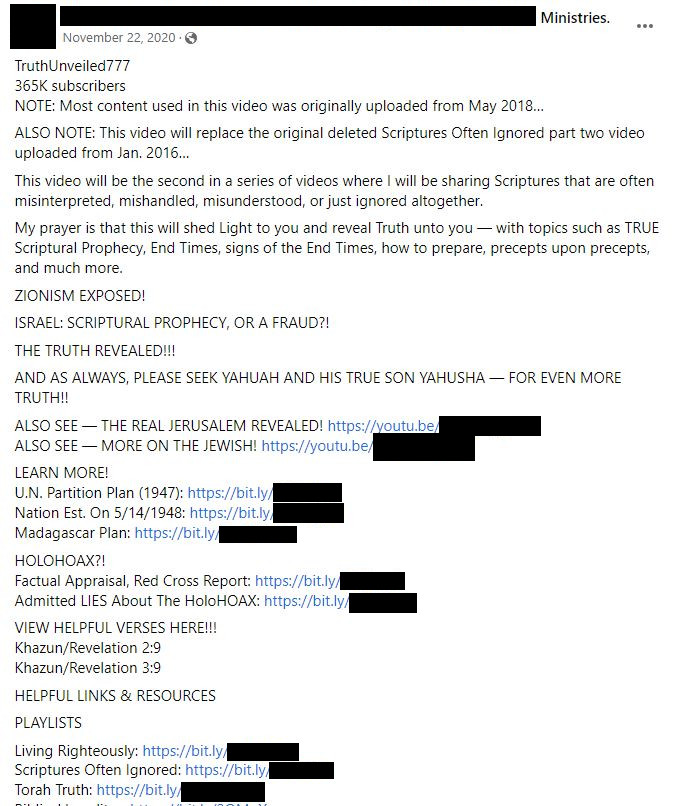
The link next to “Factual Appraisal, Red Cross Report” is to a page at Rense, one of the most antisemitic sites on the internet. Here is the page:
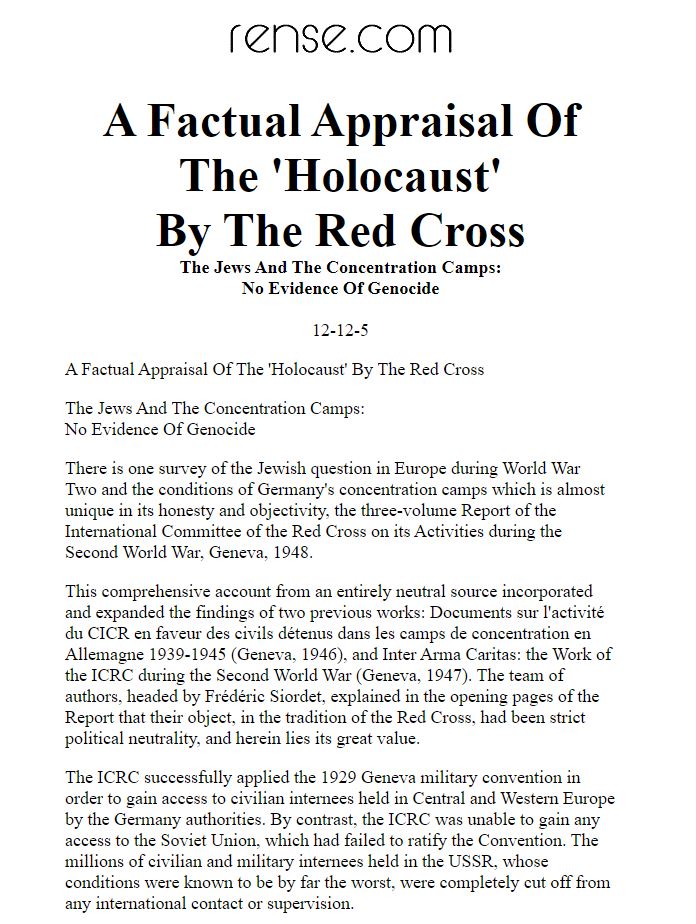
The link next to “Admitted LIES About The HoloHOAX” links to a Guardian news story about a man who falsely claimed to be a Holocaust survivor. This is an example of misrepresenting the message of the linked material.

Jews presented as Nazis
Example 16
This is a mind bending argument that Jews are really Nazis because the word for Jews who lived in the Rhineland valley and neighbouring France prior to the crusades that began in the 11th century is “Ashkenazi” and the last 4 letters of that word are “nazi”. It also makes a bizarre claim that the “zi” in this old word refers to “Zionist” and that therefore Jews are “the National Socialist – Zionist Party”. The twisted “argument” is nonsensical. It goes on with explicit Holocaust denial saying “The #HoloHOAX was FAKE and the whole thing (including the two World Wars leading up to it) was a SCAM so that the FAKE “Jew” #Sabbateans could create #Israel, because the Anti-Christ has to rule from the Third Temple in #Jerusalem.”
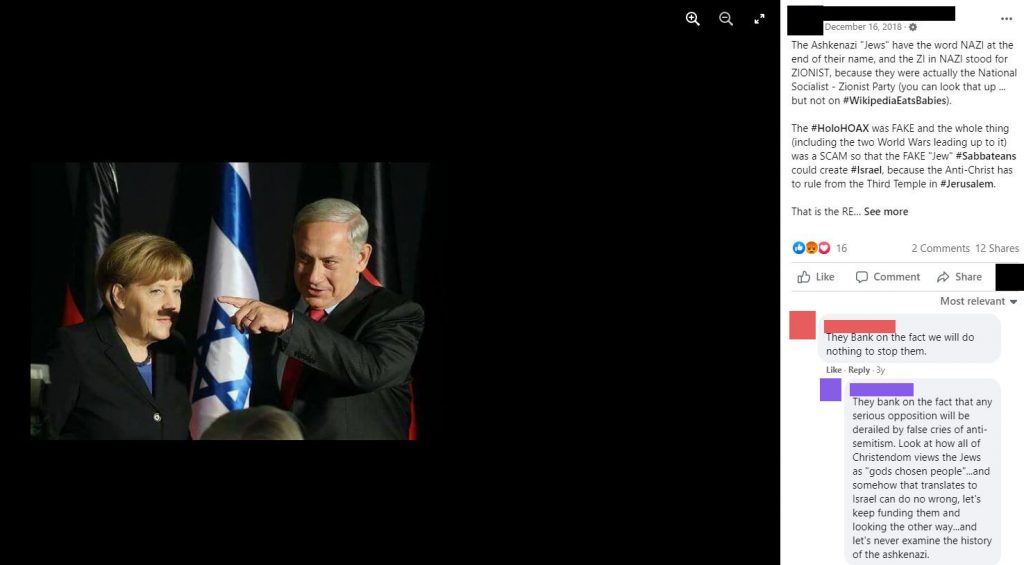
Other comments on news articles
Example 17
This is a comment on a story about a survivor, the comment is “Dem poh joos and the holohoax. lmfao” i.e. “Them poor Jews…” ‘lmfao’ refers to “Laughing My Freaking Ass Off”. It doesn’t misrepresent the article, but it mocks the fact this man survived.
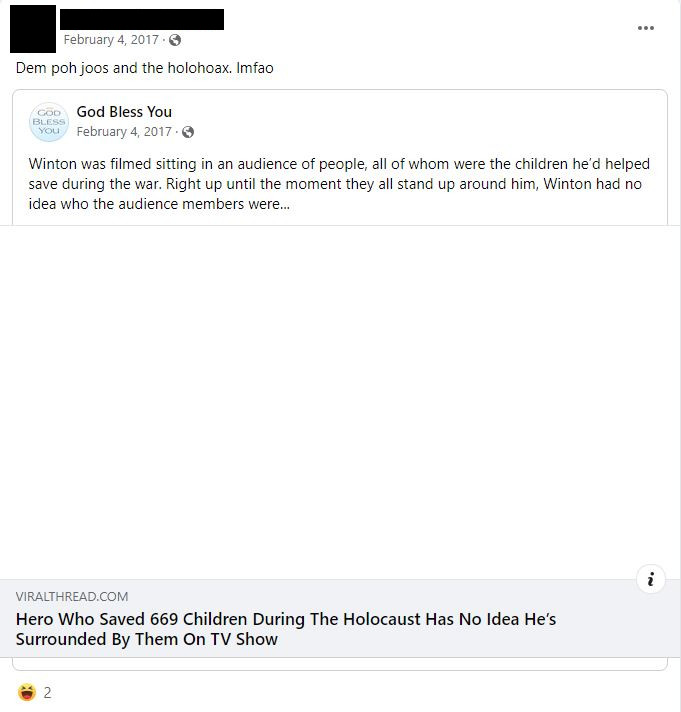
Promoting Extremism
Holocaust denial is often uses as a tool by far-right extremist groups. They seek to deny the Holocaust in order to make it easier to continue the Nazi agenda.
Example 18
This is a posted link by a page called “They Will Not Replace Us”, a slogan referring to the “great replacement” white supremacist antisemitic conspiracy theory. The same conspiracy theory referenced in multiple terrorist attacks including the Christchurch attack in 2019. The shared article is from a site “right of the right”, i.e. a far right site, which claims Jews are opposing the exhumation of bodies at an “alleged” site of a “‘massacre’” (their scare quotes). The comment spells out what the article from the far-right site is saying, “Obviously they don’t want the Holohoax exposed!”
As the AP explained, “The Polish government is reconsidering whether to exhume human remains at a World War II-era site where Jews were burned alive by Polish neighbors, though the country’s chief rabbi says the work would violate Judaism’s prohibition on disinterment under most circumstances… Some Poles want the massacre site excavated to uncover possible evidence that Germans ordered Polish villagers to do the killings… The Jedwabne pogrom was one of several massacres carried out by Poles during the German occupation. Many historians see it as evidence that anti-Semitism existed in a significant part of the Polish population. Many Polish nationalists think it is unfair to blame Poles and that Germany bears the ultimate responsibility given the methods of terror and violence Nazis used in occupied Poland.”
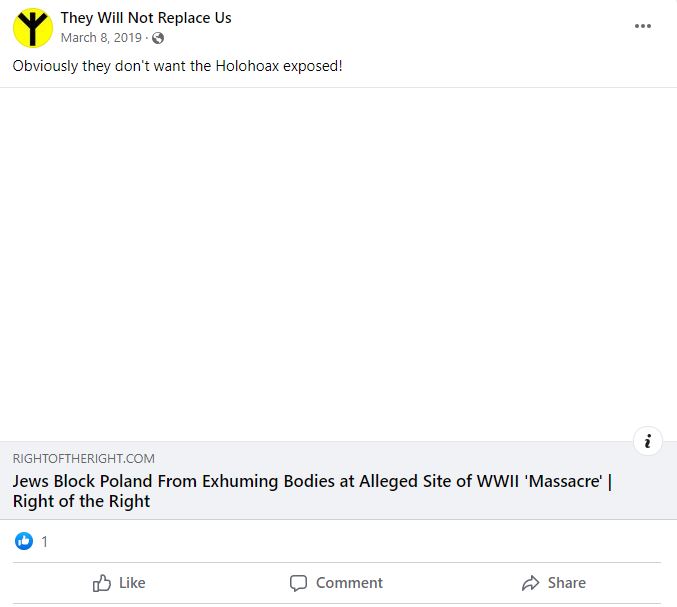
Help support work like this
The form is not published.
Acknowledgements
This briefing was created by Dr Andre Oboler, CEO of the Online Hate Prevention Institute.
Commentary on the examples has been provided by Dr Oboler, Associate Professor Philippa Smith from Auckland University of Technology, and Julie Nathan, Research Director at the Executive Council of Australian Jewry (ECAJ) and author of the annual ECAJ Report on Antisemitism in Australia.
